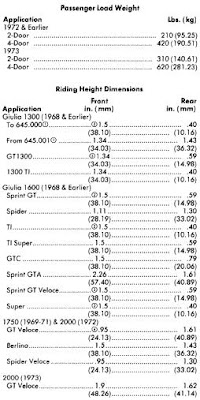1973 VOLKSWAGEN SPECIFICATIONS AND ADJUSTMENTS
TIRE INFLATION (COLD)
Before attempting to check or adjust wheel alignment, make sure tires are properly inflated. Refer to manufacturers specifications given in owner's manual.CASTER
Caster angle is part of front axle design and is not adjustable. If not within specifications, inspect fornt suspension for wear or damage and repair or replace components as necessary.CAMBER
All Models Excluding Super Beetle and Type 4 (Front) - If adjustment is necessary, loosen hex nut on upper ball joint. Using suitable tool (VW 179), adjust eccentric bushing until correct camber angle is obtained. Tighten hex nut.Super Beetle (Front) - If adjustment is necessary, loosen nut (max. one turns) on control arm bolt and turn bolt until correct camber angle is obtained. Tighten nut.
Type 4 (Front) - If adjustment is necessary, raise vehicle and loosen front carrier mounting bolts. Move carrier sideways until correct camber angle is obtained. NOTE - Vehicle must be level (laterally) on lift. If not, compensate fore lateral angle. Tighten front axle carrier bolts and lower vehicle.
All Models Excluding Type 4 (Rear) - Camber angle is dependent upon torsion bar adjustment. If camber angle is not within specifications, See Torsion Bar Adjustment.
Type 4 (Rear) - Loosen lower control arm brackets and turn on longitudinal axis. If outer bracket is lowered and inner bracket is raiised, camber angle will increase. If moved in opposite direction, camber will decrease. Adjust camber angle to specifications and tighten lower control arm brackets.
TOE-IN
Type 1 Excluding Super Beetle (Front) - With front wheel in straight-ahead position, loosen clamps on steering links (tie-rods). Turn both steering link clamps equally until correct toe-in is obtained. Tighten clamps.Super Beetle (Front) - If adjustment is necessary, position front wheels in straight-ahead position. Loosen steering link (tie-rod) clamps and turn clamps equally to obtain correct toe-in. Tighten clamps.
Type 1 and 3 (Rear) - If adjustment is necessary, loosen bottom axle tube flange. Using suitable tool (VW 160) set toe-in to specifications. NOTE - Relieve tension on tool before taking reading. Tighten bolts.
Type 4 (Rear) - If adjustment is necessary, use suitable tool (VW 361/1) and set toe-in to specifications by turning eccentric bolts on inner arm brackets.
TORSION BAR ADJUSTMENT (REAR)
Type 2 and 3 - Using suitable protractor (VW 261) find deviation of vehicle from horizontal plane and not reading, which will be used in setting angle of spring plate. Install spring plate on torsion bar and measure position (using protractor for VW 261). If not within specifications, adjust by moving torsion bar spline forward or backward until correct position is obtained.Type 2 - Using suitable protractor (VW 245A) check horizontal position of vehicle on one frame side member. Reading should be noted since it will be used in setting spring plate angle. Insert inner end of torsion bar. Adjust protractor on unloaded spring plate until bubble is in center position. Adjust torsion bar one spline forward or rearward until correct specifications are obtained.
1973 Models
1974 Models












































